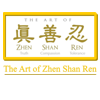After The Parade 遊行歸來
After The Parade 遊行歸來

A woman’s gazes manifests outwardly an inner calm that has survived the day’s events. Her costume—a traditional Chinese garment most likely made specially for the occasion— and the paper lotus flower cupped in her hand suggest that she has partaken in one of Falun Gong’s many parade. Such parades seek to share with spectators the beauty and grace that manifest through the practice, as well as the nobility and richness of China’s cultural heritage. In recent years many Chinese followers of Falun Gong have returned to their cultural roots, reaching back to a time predating communist rule and its devastation China’s cultural landscape. Many see in their costumes and performances the seeds of cultural renewal —a renewal that is paralleled by that in their own spiritual and personal lives. The vase at the left prominently displays the three Chinese characters: Truth, Compassion, and Tolerance. These are the virtues that facilitate such renewal and anchor the teachings of Falun Gong.
法輪大法的遊行中,由年輕女學員組成的仙女隊伍經常成為眾人矚目的焦點。她們美麗的服飾和輕盈的舞姿令人讚賞不已。實際上,不論嚴寒酷暑中,她們都必須穿著輕薄的衣裳,在行進中不斷地舞蹈。這也是非常辛苦的,然而為了讓世人能認識法輪大法,雖苦猶甜。

